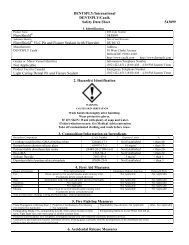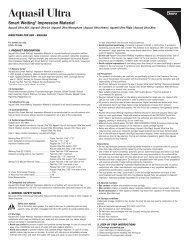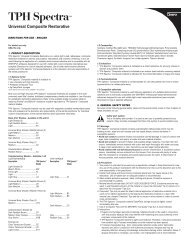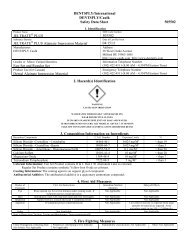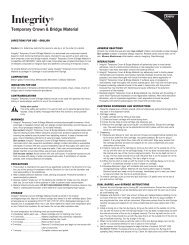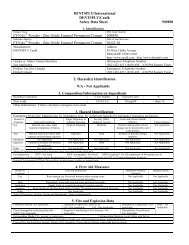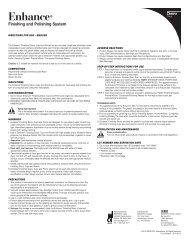Indirect and Direct Restorative Protocols - Caulk
Indirect and Direct Restorative Protocols - Caulk
Indirect and Direct Restorative Protocols - Caulk
Create successful ePaper yourself
Turn your PDF publications into a flip-book with our unique Google optimized e-Paper software.
››Principles & Practices<br />
Appropriate Bur Selection:<br />
Proper Tooth Reduction<br />
for <strong>Indirect</strong> Restorations<br />
››Abstract:<br />
The continued evolution of<br />
dental adhesives <strong>and</strong> resin<br />
cements has modified the<br />
way clinicians approach the<br />
tooth preparation required<br />
for indirect restorations.<br />
While the biomechanical,<br />
micromechanical, <strong>and</strong> chemical<br />
properties of these adhesives<br />
have increased the potential for<br />
conservative tooth preparation,<br />
the instrumentation used to<br />
create such preparations<br />
must still perform the<br />
desired tooth reduction. This<br />
presentation highlights the role<br />
of proper bur selection in fixed<br />
prosthodontic care.<br />
The biomechanical, micromechanical,<br />
<strong>and</strong> chemical properties<br />
of contemporary dental<br />
adhesives <strong>and</strong> resin cements<br />
enable practitioners to adapt a<br />
more conservative approach to tooth preparation.<br />
In each such instance, the type of<br />
restorative procedure being performed will<br />
dictate the clinician’s choice of appropriately<br />
sized <strong>and</strong> shaped instrumentation.<br />
■ ■Straight, flat-end burs—Multi-<br />
Prep carbides (DENTSPLY Professional,<br />
York, PA) facilitate effective<br />
removal of existing composite, metal,<br />
or porcelain restorations. Their<br />
cross-cut shape ensures removal of<br />
debris from the preparation site <strong>and</strong><br />
requires less force to achieve the desired<br />
cutting action. <br />
■■Tapered, dome-end carbides—This<br />
MultiPrep shape enables rapid, efficient<br />
removal of composite resin,<br />
porcelain, <strong>and</strong> natural tooth structure<br />
<strong>and</strong> produces the divergent<br />
preparation walls required for allceramic<br />
crowns <strong>and</strong> aesthetic intracoronal<br />
restorations.<br />
■ ■ Flame-shaped, safe-end burs—<br />
In order to reduce the potential<br />
of injury to gingival tissues, some<br />
Midwest® burs such as the Flame<br />
include a smooth, non-cutting end<br />
that is less likely to cause damage or<br />
irritation when used at the gingival<br />
margin.<br />
In consideration for the varying tooth<br />
sizes among pediatric <strong>and</strong> adult patients,<br />
as well as the occlusal clearances that differ<br />
among younger <strong>and</strong> geriatric patients,<br />
it is also important to select a bur with the<br />
right shank length <strong>and</strong> style. Midwest®<br />
MultiPrep Burs (DENTSPLY Professional,<br />
York, PA) are available in numerous<br />
sizes <strong>and</strong> shapes to ensure the right option<br />
is available for the anatomical requisites of<br />
a given patient (Figure 1).<br />
When treating previously restored<br />
dentition, care should be taken to select<br />
Figure 1. Prior to initiating tooth reduction, care should be taken to<br />
ensure that the bur is properly secured in the h<strong>and</strong>piece chuck.<br />
Figure 2. Midwest ® dome-shaped crosscut burs facilitate removal of<br />
amalgam or other existing restorative materials <strong>and</strong> allow for easier<br />
entry into the tooth than flat-end burs.<br />
7



